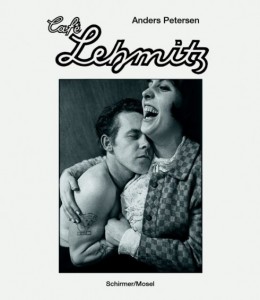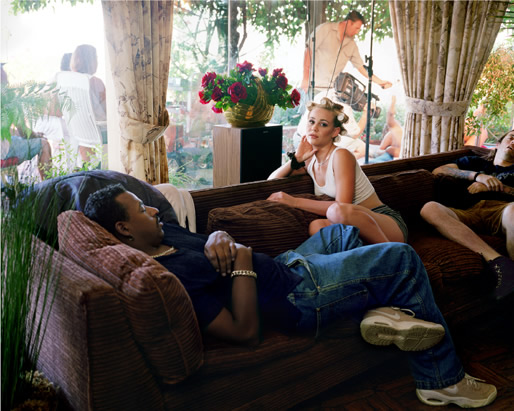This interview was originally published in the accompanying catalogue to Larry Sultan’s ‘The Valley’ exhibition at the San Francisco Museum of Modern Art.
BEGIN
Bay Area photographer Larry Sultan’s The Valley series focuses on the San Fernando Valley, where he grew up, and addresses the use of ordinary homes as sets for pornographic films. In Sultan’s large-scale color photographs, mundane objects-a roll of paper towels, a stack of dirty dishes-take on new weight, and suburban life becomes a symbolically charged backdrop. The project investigates the meaning of home and asks why the ideal of middle-class domesticity lends itself to this most curious form of cultural appropriation.
Tell me about the work you made prior to your current series, The Valley.
Growing up in the suburbs of Los Angeles provides the foundation for much of my work. I see The Valley as an outgrowth of two bodies of work that preceded it. Pictures from Home was a ten-year project exploring the myths of family life. I used my parent’s family snapshots and stills from their home movies along with photographs that I made of them to create an interweaving set of images and text that explores how photography helps to construct family history and identity. In the second body of work, I collaborated with Harrel Fletcher and John Rubin to create a store in the Stoneridge shopping mall in Pleasanton [California] that functioned as a mock documentary of the surrounding suburbs. Those two projects are both narrative in their underpinnings-they are attempts to tell stories about the complexity of life in the suburbs.
I find a lot of depictions of suburban life to be quite shallow. Either they’re hypercritical, like new topographics where tract homes are seen as generic structures for generic lives, or they’re the kind of one-dimensional dramas or sitcoms that are prevalent in popular culture. Neither of these depictions get to the complex desires or longings underlying this great American dream of suburban home ownership. To me, the suburban home is a kind of projection screen for fantasies, it’s rich for storytelling.
The Valley is an intriguing extension of Pictures from Home. How did this development come about, and how did you gain access to the adult film industry?
I was commissioned to do a magazine story on a day in the life of a porn star. I flew down to L.A. with my wife and drove from Burbank to the Valley, about a block from where I went to high school. I walked into this dentist’s house that, not unusually, had all his family pictures on display. I noticed pictures of his children and his wife, and then I noticed a tangle of bodies in the middle of the room. The friction between the reality of that familial setting and the fantasy that was being played out was so close to what I had grappled with in a lot of my prior work that I knew I had to explore it further. So I talked to the director and brought him pictures that I had taken of all the cast and crew. They were delighted with them, so they let me back on the set. I was allowed in very quietly, without ever going to studio heads directly. I came through the back door, set up relationships, and slowly it led to access. It took a long time, however, to identify what kind of sets I was interested in, what kind of directors and crews I felt comfortable with.
What is the time span of this series? How many film sets did you visit in order to make this work?
I started in the latter part of 1998 and shot until 2003. I went to probably a hundred sets.
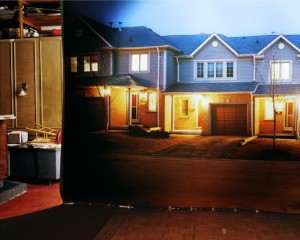
I read that 80 percent of all adult films produced in this country are made in the San Fernando Valley. Having grown up there, were you surprised to discover that this unassuming suburb of Los Angeles is the capital of the U.S. adult film industry?
No I wasn’t surprised. First, the proximity to Hollywood gives the porn industry a huge pool of talent. People who work for mainstream films — grips, directors, lighting guys, makeup and hair stylists — also work in the adult film industry. It’s kind of a parallel universe. Also it is the place where actors can go to make money when they cannot make it in mainstream films. That’s the economic and practical side.
But psychologically the Valley is also very connected to L.A. — the promise of L.A. and how the city is so embedded with the idea of stardom and happiness. Historically people have come to LA in hopes of changing and improving their lives. The Valley, too, has always been about fantasy. That’s why you have Tudor homes next to Mediterranean ones, palm trees next to pines. It’s about creating your own identity. The porn industry recognizes the lure of this fantasy-of-possibilities, it’s part of the fantasy adult film consumers are looking for as well. I find it interesting that the majority of porn consumers probably live in the suburbs, and they probably feel more comfortable with a drama that is set in the suburbs. That’s the key-your fantasy life can be found in your neighbor’s house-this makes what is desired seem attainable.
How do your pictures differ from the images adult filmmakers are seeking? You are both using the same raw material, so to speak-their sets are your settings and their actors are your models.
Well, we’re driven by completely contrary purposes. The directors want to make good films, but basically they’re being paid to do one thing — excite the viewer. That’s the opposite of what I want to do. I certainly don’t want to sexually arouse anybody. But I do want to arouse the viewer’s curiosity and sense of mystery. I’m interested not in the construction of pornography, but rather in dismantling it, in exploring domesticity, the construction of desire; all as a way of dealing with my own projections, my own nostalgia of growing up in those houses.
The key has been to collaborate with the people on the sets so that they allow themselves to be seen without the masquerade of their sexual personae. I want to show them as people. I don’t want them to be glamour girls or glamour boys — that’s a very tired set of images. I don’t think there’s any mystery left to explore there. But the artificiality of the sets is mysterious and there is something there that transforms the house into something unsettling and uncanny.
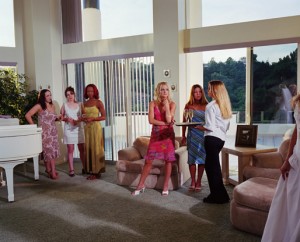
Because men make up the majority of adult film consumers, is it more difficult for a male artist to use this industry as subject matter in a way that transcends itself? Did you have any hesitations going into this project?
In her book Hardcore, Linda Williams wrote that in recent years pornography has become a cohesive study for a lot of theorists, many of whom are post-feminists or queer theorists. But she said the area seems to still be off limits to white heterosexual men, because we make up the bulk of the consumers, and to a great extent the creators, of this material. It’s a complicated subject. I don’t want to situate myself as a voyeur or as consumer. In making this work, I was aware of the questions that could be raised concerning why I am speaking about this topic or what right I have to speak about it. Until recently, I found that I was editing out all the pictures that showed sexual acts, but then I realized that there is a level of genuine pleasure on the set — there is conviviality and fun and humor. I went back and found some really wonderful pictures that I was afraid to include previously. It is a complex subject, and I think it will continue to be a complex subject, because pornography has so many undercurrents of oppression.
Your pictures show the reality, or rather the banality, of working in the pornography industry. The actors are most often portrayed detached from their film personas; we see them on a cigarette break, talking on their cell phone, or sitting around in curlers. Could you talk about the how the actors are portrayed in your pictures?
I don’t think there is complete consistency. Sometimes they’re seen very clearly as actors in a drama they’re not in control of — they seem wary of or victimized by it. Sometimes they seem absolutely in control of the camera’s gaze-and getting pleasure from their power of seduction.
In my photographs, I’m essentially casting an alternate film. My drama is not centered around sexuality, but rather around domestic relations, family relations. Who are these people? What is their relationship to each other? Sometimes they have relationships very directly connected to my own childhood memories. There’s a sense of pleasure in the suburbs. This is a place where, in the middle of the day, everyone stops work and has a great time together. The other side is very dark and isolating and lonely and lost. Both of those ways of experiencing the suburbs are operating simultaneously in my pictures. The actors often reveal their relationship to the industry in a way that parallels my relationship to the suburbs — one that embodies both pleasure and boredom.
To me the documentary side of this work — or the illusion of documentary — is very important. I want to refer to life rather than to the films. My photographs reference the artifice of pornography, but they also capture real people in their own genuine moments. For example, a man is shown standing in the kitchen, looking out the window. He happens not to have any clothes on, but for me, that picture recalls a really poignant moment where, in the middle of the day you have a cold glass of water and you look out the window and wonder, what am I doing here?
Your work has a witty edge to it; I recognize this not just in The Valley but also in your previous bodies of work. To what effect do you use humor in these pictures?
I find the situations quite hilarious at times-strange in the smallest ways. Sometimes it’s just the settings — those home interiors are so wild. Sometimes it’s the visual puns that occur between the materials of the couch and the fireplaces and then the bodies-naked bodies can be quite humorous in a situation where you don’t expect to see them. Sometimes it’s funny because there’s mischief being played out. I’m interested in the kind of mischief that upturns the house, takes the order and control out of what we think of as domestic life, and really creates a kind of excess where things spill out like in a carnival, where the whole house is vibrating like a washing machine on its spin cycle. It’s loony, and it’s sexual, and it’s out of control. I love that quality of things being out of control, especially in the suburbs, because suburbia is the height of imposed control. Life in the suburbs is monitored by parents, neighbors, police. For about an hour on the set, none of the rules or codes apply — that craziness can be funny.

While some of your pictures make use of the industry’s cinematic lighting for dramatic effect, you have also included some seemingly ordinary domestic scenes in the series: a kitchen counter with dirty dishes piled in the sink and over-decorated interiors or backyards. These everyday views, which are familiar to all of us, take on a darker suggestiveness in the context of the other photographs. Why did you choose to include these pictures?
I think these pictures do a very important job. They take the narrative momentum, and the context in which you expect a certain kind of sexual drama, and they condense it, they quiet it down, they bring it back to the ordinary, back to the mundane. Many of them also have an elegiac quality of loss and vulnerability. While these pictures establish the homey-ness of the setting, the other pictures undo that sense of home. They speak to the fragility of our sense of order. Together, the pictures simultaneously construct and dismantle domestic life. I think this is kind of a swan song for our post-war American family dreams.
The majority of your pictures do not reveal whatever activity is being played out for the film cameras. In some cases you photograph the scene in such a way that furniture or the film crew actually obscure the line of vision. You also make use of strategic cropping to add ambiguity to what we are looking at. This approach not only places the burden back on the viewer to decode the picture, but it also underscores the act of looking. In contrast to easily consumable adult film plots, your pictures require more interpretation by the viewer. What was your strategy in photographing the more deliberately enigmatic pictures such as Havenhurst?
For one it’s very important that a viewer situate themselves in my pictures. Discovering the picture’s meaning is an open field of wandering — the open-endedness of the pictures is really important. This is particularly true of the images where the situation is not quite clear. In some cases, I compose the picture so that the subject matter does not overwhelm the photograph. In some pictures where I’ve actually obscured the sexual act, I’ve done it in a way that forces the viewer to look at areas on the periphery. Your eye wanders around the picture, allowing you to notice other details.
In Canopy, Woodland Hills, for instance, the ceiling is much more important than the actor in the scene, because that kind of cottage cheese-like ceiling is the ceiling of my childhood. It carries with it so much that identifies the psychology of this place. I play a certain cat-and-mouse game. If I show too much, I’ve killed the picture — it’s no longer interesting to me. If I show too little, it appears I’m being coy.
A photograph constructs reality through what the frame excludes as much as what it contains. You address this concept in a very sophisticated way by making photographs that critique the medium of photography itself. The perception of a photograph as a document of truth seems antiquated, yet it can be easy for viewers to forget that photographs are not pure representations of reality, to forget that photography is a medium that creates fiction as much as any other. What are the comparisons you are drawing between the fiction of photography and those of middle-class identity or the adult film industry? You’ve found a very unique intersection of those three things.
There are a number of things I’m interested in here. I’m very conscious that I grew up in a family where the home was a theatrical setting. As a child, my parents hired a decorator, and she painted a grape tree in the living room and put rubber grapes on its tendrils. She also put gold leaf on a Picasso print so that it looked like Picasso had painted in gold. We had shag carpets, and our living room was one that no one went into. We lived in that kind of situation where our family house was a theater. Family life is already a stage — home is situated as a symbol of the good life and as an extension of our desired identities.
There is a kind of ethnographic quality to observing these sets. I feel like a forensic photographer at times, looking for the trace that has been left on the manicured home by the event staged within it. I wonder how the house recovers from the event of a porn film? How does a family occupy a house after they’ve given it up for a day?
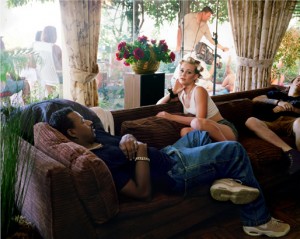
These photographs function in several ways; they raise questions about domesticity, artifice, spectatorship, and the nature of representation. Although the setting and players are of the porn industry, your subject is really much broader and more complex. How would you describe this work to someone who has not seen it?
It’s really important for me to convey that I’m coming back home to where I grew up. I’m returning to this neighborhood where people are out watering lawns in the last light of the day or bringing in the trash. All that familiarity is paired with this weird scene where women with really high heels and men with tattoos all over the place are lined up on the street like a fire drill and you think, “What are they doing in the suburbs? They don’t belong here.” This ordinary landscape has gotten strange.
In this fiction things are happening that shouldn’t: people aren’t going to work, a delivery boy comes to the door and he’s asked in, a couple walking up the street with suitcases is asked in for lunch, and then there’s this neighbor who’s looking for a cup of sugar, and all of a sudden she is invited into a place in which everything is suspended for an afternoon of pleasure.
That level of fantasy can be compared to the fantasy I grew up with, in terms of an idyllic life where the father was always dressed up in a tie and he’d call his son Junior and his daughter Babs and he’s always home. Well none of our dads were ever home because they were traveling salesmen. I’m interested in portraying a world that compensates for what we’re missing — the plentitude that we would like to see that isn’t there. My work is really about trying to show suburban life as complex as I think it is, through metaphors and stories, about trying to tell these stories clearly and poignantly without them becoming clichés, about recovering some of the longing and loss of this familiar American-dream landscape.
Larry Sultan is a professor in the photography department at California College of Art. He has been the recipient of numerous grants and awards, including a Guggenheim Fellowship and five National Endowment for the Arts Photography Fellowships. His work has been featured in many exhibitions and public art projects, including Larry Sultan: Pictures from Home, which opened at the San Jose Museum of Art in 1992 and traveled to six additional venues.
Terri Whitlock is a curatorial associate in the Department of Photography at the San Francisco Museum of Modern Art. She assisted Sandra S. Phillips, senior curator of photography, in organizing Larry Sultan: The Valley for the Museum.
Larry Sultan: The Valley is organized by the San Francisco Museum of Modern Art.
